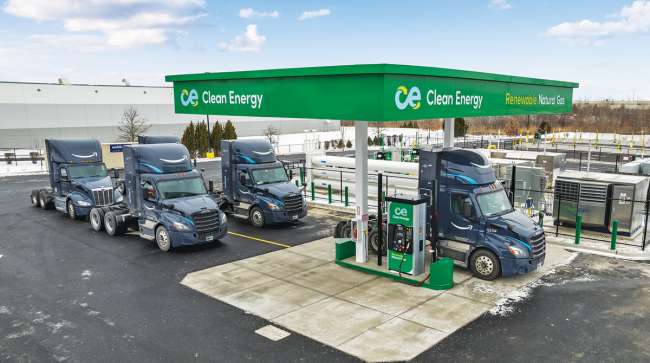Emerging Options in the Trucking Industry
In recent years, the trucking industry has witnessed a noticeable shift towards more sustainable fuel options. The rise of renewable natural gas (RNG) is becoming a significant player in this transformation, offering a cleaner alternative to traditional diesel fuel. This change is not only good for the environment but also practical for businesses in logistics and transportation.
The Benefits of RNG
Natural gas-powered tractors that operate on RNG can reduce nitrogen oxide emissions by an impressive 90% compared to their diesel counterparts, as highlighted by ICF analysis. This drastic reduction of harmful emissions has captured the attention of various trucking companies aiming to meet stricter environmental regulations.
Infrastructure and Fuel Supply
Despite the challenges surrounding fuel range and refueling infrastructure, the path ahead for RNG is becoming clearer. The recent data shows that over 774 million gallons of gasoline equivalent were consumed by natural gas vehicles in the U.S. in 2024. Notably, around 86% of these were fueled by RNG, indicating a promising trend toward greener fuel sources.
A gallon of gasoline equivalent (GGE) is commonly used to measure compressed natural gas at public fueling stations, with the diesel gallon equivalent (DGE) accounting for slightly more energy. This framework facilitates easier comparison and adoption of RNG.
Tuotanto- ja markkinatrendit
According to projections from Wood Mackenzie, North America’s RNG production capacity is expected to reach 604 million cubic feet per day by the end of 2025. This anticipated growth reflects an increase of 70 mmcf/d in 2025 and 139 mmcf/d in 2024, illustrating the burgeoning demand for RNG fuel.
Importantly, RNG is also compatible with existing natural gas pipelines, making the transition to this cleaner fuel much more feasible without the need for extensive new infrastructure.
Innovations in Trucking Technology
Innovations such as the Cummins X15N engine are paving the way for greater acceptance of RNG in the trucking sector. With back-of-cab fuel storage systems ranging from 60 to 175 DGE, and side or rail mount tanks accommodating 30-100 DGE, these engines are designed to meet long-haul requirements efficiently.
The X15N, launched by Cummins as a high-performance natural gas engine, has already captured the attention of major truck manufacturers. Freightliner, the best-selling Class 8 tractor in America, began taking orders for tractors equipped with this advanced engine, signifying a major step toward integrating RNG into mainstream trucking.
Changing the Landscape of Trucking
This shift toward RNG is not solely limited to refuse trucks or school buses. With the introduction of advanced models powered by X15N engines, the trucking industry is on the cusp of a substantial transformation. Freightliner has already indicated that they’re ready for customers looking to purchase Cascadias equipped with this cutting-edge technology. This represents a significant movement towards cleaner freight options across the country.
Logistics and Economic Implications
From a logistics perspective, the rise of RNG presents various implications for shipping, freight, and distribution operations. Logistics management must focus on integrating these new technologies into existing systems for a smooth transition. As logistics professionals seek more luotettava ja kustannustehokas solutions, RNG-powered trucks offer a viable path to achieving those goals without sacrificing performance.
U.S. RNG producers predict a need to generate around 115 to 120 million gallons of RNG by 2026 to meet demand if the X15N achieves its market share objectives, according to Clean Energy Fuels. As the market grows, businesses in logistics will need to adapt to align their transport strategies with these emerging trends and regulations.
Regulatory Support and Market Growth
As RNG production scales up, regulatory support through initiatives like the alternative fuel tax credit for natural gas motor fuels signals government engagement in promoting sustainable fuel adoption. The Senate recently extended this credit, offering a solid foundation for long-term investment in RNG infrastructure.
Päätelmä
The shift towards renewable natural gas signifies a promising outlook for the trucking industry. It aligns with current efforts to enhance sustainability in logistics while balancing economic necessities. The integration of RNG can streamline operations and improve emissions standards even as demand for freight transport continues to grow.
While reviews and feedback can provide valuable insights into the efficacy of RNG in trucking, nothing compares to personal experience. GetTransport.com offers a transparent and cost-effective platform for cargo transportation, ensuring logistics professionals navigate this evolving landscape efficiently. To simplify logistics for your next move, rely on the dependable and diverse solutions provided by GetTransport.com to meet your unique needs. Aloita seuraavan toimituksen suunnittelu ja varmista rahtisi GetTransport.comin avulla.

 Uusiutuva maakaasu: Kaukokuljetuskuorma-autoliikenteen muuttaminen">
Uusiutuva maakaasu: Kaukokuljetuskuorma-autoliikenteen muuttaminen">